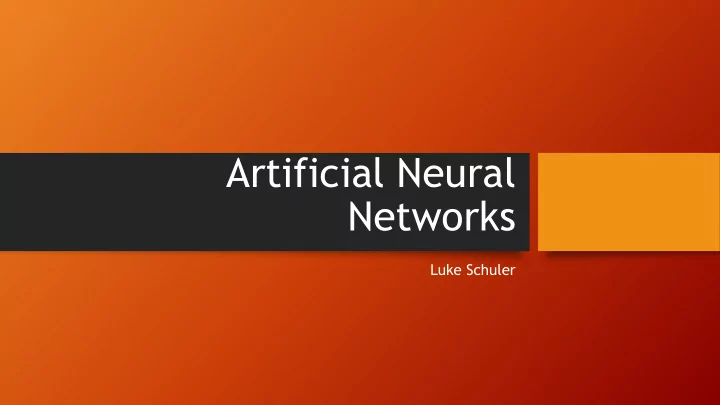

Artificial Neural Networks Luke Schuler
Overview • What is an Artificial Neural Network? • History • Inception • Abandonment • Resurgence • Model • Training • Applications
What is an Artificial Neural Network? • An artificial neural network, or ANN, is either an algorithmic or hardware processing device that is loosely modeled after the structure of neurons in the brain • Neuron – Electrically excitable cell that processes and transmits information through electrical and chemical signals • Core components of the brain, spinal cord, and central nervous system
History • 1943 • Warren S. MucCulloch and Walter Pitts Published “A Logical Calculus of the Ideas Immanent in Nervous Activity” in Attempted to understand how complex patterns could be produced by the brain, using only basic cells which are connected to each other — neurons. • Highly simplified model of a neuron called MCP Neuron
MCP Neuron – Threshold Logic Unit
History – Cont. • 1949 Neuroscientist Donald Hebb • Neuroscientist Donald Hebb Published The Organization of Behavior • Described Hebbian Learning, in which the activation of two neurons simultaneously results in a stronger link, or synaptic strength, between those two neurons • Provides a biological basis for errorless learning methods • Used to determine how to alter the weights between model neurons
History – Cont. • 1958 • Rosenblatt designs and creates the Perceptron • Perceptron – algorithm designed for supervised learning of binary classifiers, or functions that decide which of two classes to which an input belongs • Sparks more interest in the field of neural networks with middle “association” layer, which could learn to connect or associate a given input to a random output unit
History – Cont. • 1960 • ADALINE – ADAptive Linear Environment • Developed by Stanford’s Widrow and Hoff • Analogue device that used the Least-Mean-Squares learning rule in order to learn, rather than an association layer like the Perceptron
History – Cont. • 1969 • Research begins to stagnate • Publication by Seymour Papert and Marvin Minskey • Two key issues with computational machines that processed neural networks • Single-layer neural networks incapable of processing XOR • Computers of the time too limited in processing power to handle long-run time required by large neural networks • ANN research impractical at this time
History – Cont. • Late 2000’s • Advent of “deep learning” stirs coals of ANNs • Geoffrey Hinton and Ruslan Salakhutdinov • Deep Learning – a many-layered ANN can be pre-trained one layer at a time, then fine-tuned using supervised backpropagation
Model • Network – Neurons’ connections throughout system’s different layers • One layer sends data through “synapses” to next layer, etc. • Each synapse stores a weight, changing calculation data • The more complex the system, the more neurons
Model – Cont. • ANN made up of 3 parameters • Pattern of connections between neuron layers • Learning rule which updates weight of connections • “Activation Function” which converts a neuron’s weighted input to its output activation
Training • Multilayered Perception Architecture • Trained by back-error propagation • Organized as a set of layers of artificial neurons, which are fully interconnected to each other
Training – Cont.
Applications • Data processing • Function approximation or regression analysis • Classification using pattern and sequence recognition • Control systems engineering • Robotics, including the direction of manipulators and prosthesis
Recommend
More recommend